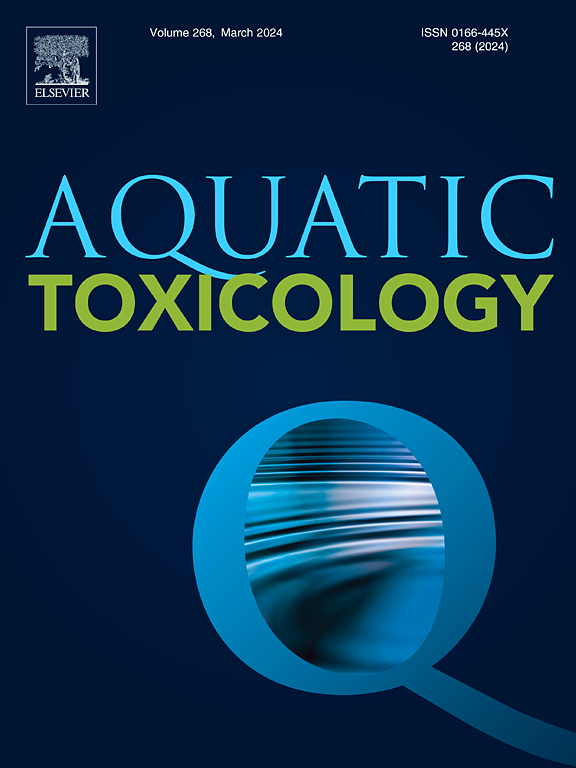TBBPA通过ROS/NF-κB信号引起鲤鱼多处肠道损伤。
IF 4.1
2区 环境科学与生态学
Q1 MARINE & FRESHWATER BIOLOGY
引用次数: 0
摘要
四溴双酚A (TBBPA)是水生环境中普遍存在的污染物,对水生动物的健康构成极大威胁。肠道是营养吸收的重要器官,也是防止污染物侵入鱼类身体的重要屏障。探讨污染物对肠道的影响对维持鱼类健康具有重要意义。因此,本研究的目的是通过建立暴露于TBBPA的鲤鱼和原代肠上皮细胞模型,来评估TBBPA对鲤鱼肠道的毒性作用。组织学观察显示,TBBPA暴露导致肠黏膜损伤和肠绒毛断裂。氧化应激水平检测显示,TBBPA增加了肠道组织和细胞中ROS和MDA的水平,降低了SOD、CAT、GSH-PX和T-AOC的活性。观察炎症因子水平发现,TBBPA上调炎症因子(IL-6、TNF-α、IL-1β、NF-κB p65、i -κB α) mRNA水平。ELISA和western blotting结果与mRNA结果一致。TUNEL染色和流式细胞术证实,TBBPA诱导细胞死亡,Bax、cas3、Cyt C、RIP1、RIP3、MLKL水平升高,Bcl-2水平降低。TBBPA还通过降低claudin-1、ZO-1和occludin的mRNA和蛋白水平破坏肠紧密连接。综上所述,本研究揭示了TBBPA通过ROS/NF-κB信号引起鲤鱼肠道损伤,诱导氧化应激、炎症、细胞死亡和紧密连接破坏。本文章由计算机程序翻译,如有差异,请以英文原文为准。
TBBPA caused multiple intestinal injuries via ROS/NF-κB signal in common carp
Tetrabromobisphenol A (TBBPA) is an aquatic environment's prevalent pollutant, posing a great threat to the health of aquatic animals. The intestine is a key organ for nutrient absorption as well as an important barrier to prevent pollutants from invading the body of fish. Exploring the effects of pollutants on the intestine is of great significance for maintaining fish health. Therefore, the purpose of this study was to assess the toxic effects of TBBPA on the intestine of Cyprinus carpio L. (common carp) by establishing models of common carp and primary intestinal epithelial cells exposed to TBBPA. Histological observation revealed that TBBPA exposure led to damage in the intestinal mucosa and breakage of intestinal villi. Detection of oxidative stress levels showed that TBBPA increased the levels of ROS and MDA, and decreased the activity of SOD, CAT, GSH-PX, and T-AOC in intestinal tissue and cells. Observation of inflammatory factor levels revealed that TBBPA upregulated the mRNA levels of inflammatory factors (IL-6, TNF-α, IL-1β, NF-κB p65 and IκBα). ELISA and western blotting results were consistent with the mRNA results. Moreover, TBBPA induced cell death, as evidenced by TUNEL staining and flow cytometry and confirmed by increasing levels of Bax, Cas-3, Cyt C, RIP1, RIP3, and MLKL, together with decreasing the levels of Bcl-2. TBBPA also destroyed the intestinal tight junction by reducing the mRNA and protein levels of claudin-1, ZO-1, and occludin. In summary, this study reveals that TBBPA caused intestinal injuries, inducing oxidative stress, inflammation, cell death, and tight junction disruption via ROS/NF-κB signal in common carp.
求助全文
通过发布文献求助,成功后即可免费获取论文全文。
去求助
来源期刊

Aquatic Toxicology
环境科学-毒理学
CiteScore
7.10
自引率
4.40%
发文量
250
审稿时长
56 days
期刊介绍:
Aquatic Toxicology publishes significant contributions that increase the understanding of the impact of harmful substances (including natural and synthetic chemicals) on aquatic organisms and ecosystems.
Aquatic Toxicology considers both laboratory and field studies with a focus on marine/ freshwater environments. We strive to attract high quality original scientific papers, critical reviews and expert opinion papers in the following areas: Effects of harmful substances on molecular, cellular, sub-organismal, organismal, population, community, and ecosystem level; Toxic Mechanisms; Genetic disturbances, transgenerational effects, behavioral and adaptive responses; Impacts of harmful substances on structure, function of and services provided by aquatic ecosystems; Mixture toxicity assessment; Statistical approaches to predict exposure to and hazards of contaminants
The journal also considers manuscripts in other areas, such as the development of innovative concepts, approaches, and methodologies, which promote the wider application of toxicological datasets to the protection of aquatic environments and inform ecological risk assessments and decision making by relevant authorities.
 求助内容:
求助内容: 应助结果提醒方式:
应助结果提醒方式:


